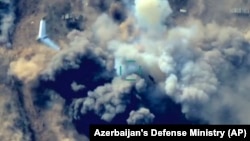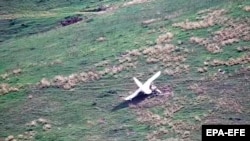Out of the sky, whirring its distinctively terrifying buzz, a drone zipped over the arid landscape as soldiers fired rifles at it and then slammed into a small bus, sending up a fiery plume.
“Where are you, bastards?” one of the soldiers yells in Armenian as others try to shoot it down.
Unmanned aerial vehicles, like the one shown in a video that circulated widely on social media last week, aren’t new to the Nagorno-Karabakh conflict. Four years ago, when the last spasm of serious fighting erupted, so-called “kamikaze drones” were employed. It was the same again in July, when there was another small outbreak of shooting.
Recognized internationally as part of Azerbaijan, Nagorno-Karabakh has been under the control of ethnic Armenian forces since the 1994 cease-fire that brought an end to full-scale war that broke out two years earlier.
Now Armenian and Azerbaijani forces are engaged in the fiercest fighting since a 1994 cease-fire. And drones are being used to a far greater extent than ever before, helping to shape the battlefield and offering a glimpse of how future wars are likely to be fought in the Caucasus and elsewhere.
It’s no secret to anyone closely watching since the latest fighting erupted on September 27. The president of Azerbaijan, which experts say has amassed a sizable and diverse fleet of unmanned aerial vehicles, bragged openly about the weapons in an interview earlier this week.
“Thanks to the advanced Turkish drones owned by the Azerbaijan military, our casualties on the front have shrunk,” Ilham Aliyev told a Turkish TV channel. “These drones show Turkey’s strength, and this also empowers us.”
Wreckage of crashed and shot-down drones is already littering the landscape in and around Nagorno-Karabakh -- and social media, including those used by the defense ministries of Armenia and Azerbaijan, are littered with photos and videos of drones in action.
Open-source researchers have pinpointed the video that circulated last week, saying the incident appeared to have occurred in Armenia, not Nagorno-Karabakh. Armenian officials have insisted no one died in the kamikaze attack.
Neither Armenia nor Azerbaijan has sizable air forces: Armenia is believed to have fewer than 18 Sukhoi fighter jets, plus attack helicopters and transport and training aircraft.
Azerbaijan, meanwhile, is estimated to have around 30 MiG and Sukhoi jets from Russia, plus some attack helicopters and sundry training and transport aircraft. Aliyev also recently confirmed sightings of Turkish F-16 jets on Azerbaijani territory, a development that signaled Ankara’s deepening involvement.
Still, given how expensive fighter jets are, plus the potential danger of their pilots being shot down, UAVs are a much cheaper and more versatile tool for small-scale battlefields like in Nagorno-Karabakh, experts said.
“For two countries with limited airpower capabilities, UAVs provide a cheap alternative to expand their strike potential and their intelligence, surveillance, and reconnaissance,” said Mike Fowler, associate professor of military and strategic studies at the U.S. Air Force Academy. “Plus, there is the added bonus that if your plane is shot down, there is no pilot to capture.”
Of the two belligerents, Azerbaijan has used its drones much more liberally than Armenia, which has a far smaller fleet, and Baku has targeted Armenian tanks, artillery, and even air-defense systems.
“It’s not easy to knock out those anti-drone and antimissile systems with a drone or a missile,” Matthew Bryza, a former U.S. ambassador to Azerbaijan, told RFE/RL in an interview last week. “So Azerbaijan appears to have shown a high degree of capability in that situation.”
Awash in revenues from the sale of its sizable oil and gas reserves, Baku has for years been building up its military forces, spending billions to buy mainly Russian weaponry and equipment.
But Russia’s defense industry has lagged in developing unmanned aerial vehicles, with the United States largely pioneering technology and tactics for using them.
So Azerbaijan has turned to Israel, and more recently Turkey, to build up its drone capabilities. Prior to this latest outbreak, researchers estimated Azerbaijan had fewer than 200 models.
Among those, according to the Center for the Study of the Drone at Bard College in the United States, are the Harpy and Harop vehicles, manufactured by Israel Aerospace Industries, and the Orbiter 1K, from Aeronautics Group. Other acquisitions include models known as Hermes, Heron, and SkyStriker.
While most of the models can do regular surveillance, transmitting data and video to a ground station, many more can also be mounted with explosives, allowing them to be crashed into targets, becoming what is known formally as a “loitering munition” or informally as “kamikaze” or “suicide” drones.
Azerbaijan has also been buying less-sophisticated Russian-built An-2s.
More significantly, it has been acquiring a Turkish-made model called the Bayraktar TB2. Mostly comparable to U.S.-made Reaper or Predator drones, the TB2 has already been used extensively by Turkey in Syria and, reportedly, in Libya.
“TB2s are having significant effect on the battlefield” in Nagorno-Karabakh, said Rob Lee, a former U.S. Marine Corps officer and war studies researcher with King’s College London. “We’re seeing battlefield gains for Azerbaijan that we haven’t seen in 20, 25 years now.”
And it may not be the Azerbaijanis who are flying the drones. Fowler said it was likely that trained Turkish military personnel were operating the TB2 drones.
“While the drone is unmanned, it is not a robot. They need some type of facility for pilots and sensor operators...all of which require training. Plus, they need specialized maintenance personnel and logistics systems for spare parts,” he told RFE/RL. “Running your own drone operation is a significant investment. Unless, of course, someone else is running it on your behalf.”
Homegrown Drones
For several years now, Azerbaijan has also had the ability to manufacture drones itself, under license from Israel’s Aeronautics Group. That’s given Baku more flexibility in how and where it can deploy the vehicles.
Dan Gettinger, who founded the Bard College drone center and who now works as an analyst for the Washington-based Mitchell Institute for Aerospace Studies, said accurate information is still hard to come by in the ongoing conflict. With both sides giving misleading or incomplete data, researchers must often rely on social media.
But the newest development, he said, appears to be an increased use of kamikaze drones by Azerbaijan.
“There appears to be a greater reliance or emphasis on using loitering munitions as a precision tool to affect battlefield gains by Azerbaijan,” Gettinger told RFE/RL.
Experts said Armenia has a far smaller drone and UAV fleet; its armed forces announced in 2011 that the country had developed its own domestically built craft called the Krunk followed by two other models called the Baze and the Ptero-5.
All are designed for reconnaissance and surveillance, however, not for suicide missions. It was unclear to what extent the units were being used in the current fighting. Estimates put Armenia’s overall fleet at only a few dozen at most.
The overall death toll from the fighting has been hard to come by. As of October 9, Nagorno-Karabakh's military says at least 350 of its soldiers have been killed. Azerbaijan has not released casualty figures. Dozens of civilians have also been wounded and killed on both sides.
Nor are there are reliable figures for the number of drones that have been shot down.
On October 2, Armenia’s Defense Ministry claimed that 107 Azerbaijani UAVs had been downed, though some may have been kamikaze drones that were crashed on purpose.
Another important aspect of drone warfare is psychological operations and propaganda: recording videos and photos of attacks of enemy.
Azerbaijan’s Defense Ministry, for example, has churned out a daily feed on Twitter and Telegram, with drone videos purporting to show missile attacks and kamikaze drone strikes on Armenian forces.
Both sides have sought to document crashed drone wreckage, as a way to accuse their opponent of war crimes or targeting of civilians.













